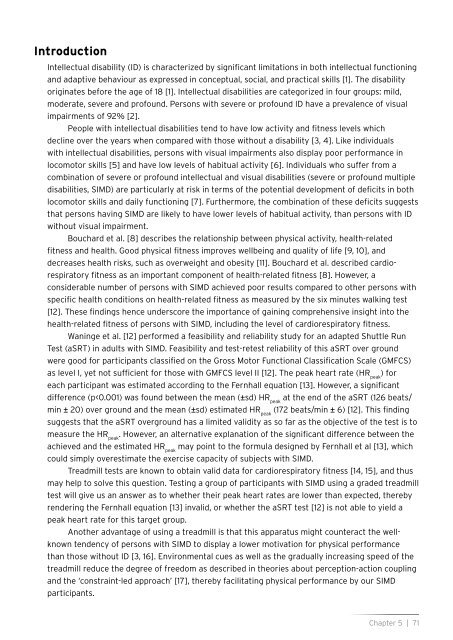Measuring physical fitness in Persons with Severe/Profound ...
Measuring physical fitness in Persons with Severe/Profound ...
Measuring physical fitness in Persons with Severe/Profound ...
- No tags were found...
You also want an ePaper? Increase the reach of your titles
YUMPU automatically turns print PDFs into web optimized ePapers that Google loves.
IntroductionIntellectual disability (ID) is characterized by significant limitations <strong>in</strong> both <strong>in</strong>tellectual function<strong>in</strong>gand adaptive behaviour as expressed <strong>in</strong> conceptual, social, and practical skills [1]. The disabilityorig<strong>in</strong>ates before the age of 18 [1]. Intellectual disabilities are categorized <strong>in</strong> four groups: mild,moderate, severe and profound. <strong>Persons</strong> <strong>with</strong> severe or profound ID have a prevalence of visualimpairments of 92% [2].People <strong>with</strong> <strong>in</strong>tellectual disabilities tend to have low activity and <strong>fitness</strong> levels whichdecl<strong>in</strong>e over the years when compared <strong>with</strong> those <strong>with</strong>out a disability [3, 4]. Like <strong>in</strong>dividuals<strong>with</strong> <strong>in</strong>tellectual disabilities, persons <strong>with</strong> visual impairments also display poor performance <strong>in</strong>locomotor skills [5] and have low levels of habitual activity [6]. Individuals who suffer from acomb<strong>in</strong>ation of severe or profound <strong>in</strong>tellectual and visual disabilities (severe or profound multipledisabilities, SIMD) are particularly at risk <strong>in</strong> terms of the potential development of deficits <strong>in</strong> bothlocomotor skills and daily function<strong>in</strong>g [7]. Furthermore, the comb<strong>in</strong>ation of these deficits suggeststhat persons hav<strong>in</strong>g SIMD are likely to have lower levels of habitual activity, than persons <strong>with</strong> ID<strong>with</strong>out visual impairment.Bouchard et al. [8] describes the relationship between <strong>physical</strong> activity, health-related<strong>fitness</strong> and health. Good <strong>physical</strong> <strong>fitness</strong> improves wellbe<strong>in</strong>g and quality of life [9, 10], anddecreases health risks, such as overweight and obesity [11]. Bouchard et al. described cardiorespiratory<strong>fitness</strong> as an important component of health-related <strong>fitness</strong> [8]. However, aconsiderable number of persons <strong>with</strong> SIMD achieved poor results compared to other persons <strong>with</strong>specific health conditions on health-related <strong>fitness</strong> as measured by the six m<strong>in</strong>utes walk<strong>in</strong>g test[12]. These f<strong>in</strong>d<strong>in</strong>gs hence underscore the importance of ga<strong>in</strong><strong>in</strong>g comprehensive <strong>in</strong>sight <strong>in</strong>to thehealth-related <strong>fitness</strong> of persons <strong>with</strong> SIMD, <strong>in</strong>clud<strong>in</strong>g the level of cardiorespiratory <strong>fitness</strong>.Wan<strong>in</strong>ge et al. [12] performed a feasibility and reliability study for an adapted Shuttle RunTest (aSRT) <strong>in</strong> adults <strong>with</strong> SIMD. Feasibility and test-retest reliability of this aSRT over groundwere good for participants classified on the Gross Motor Functional Classification Scale (GMFCS)as level I, yet not sufficient for those <strong>with</strong> GMFCS level II [12]. The peak heart rate (HR peak) foreach participant was estimated accord<strong>in</strong>g to the Fernhall equation [13]. However, a significantdifference (p











